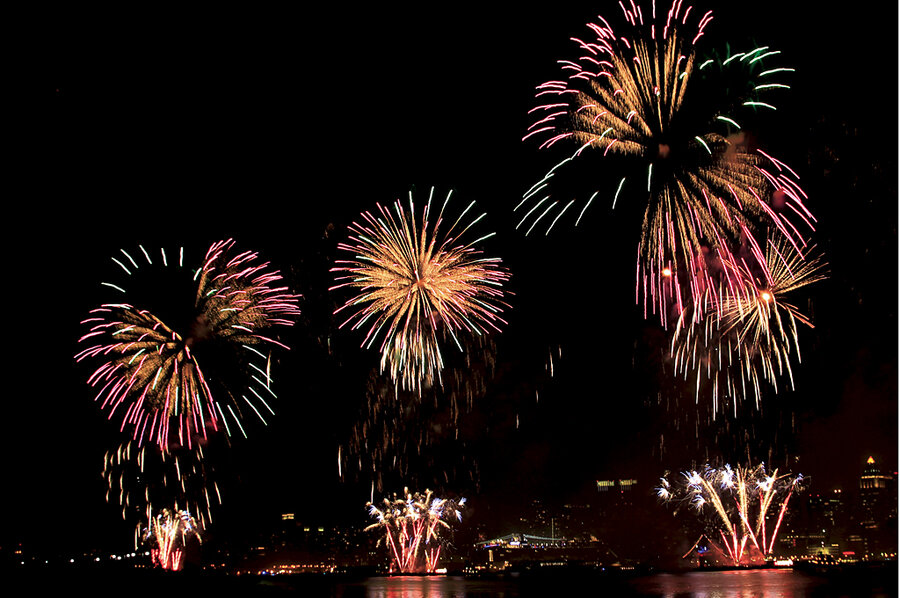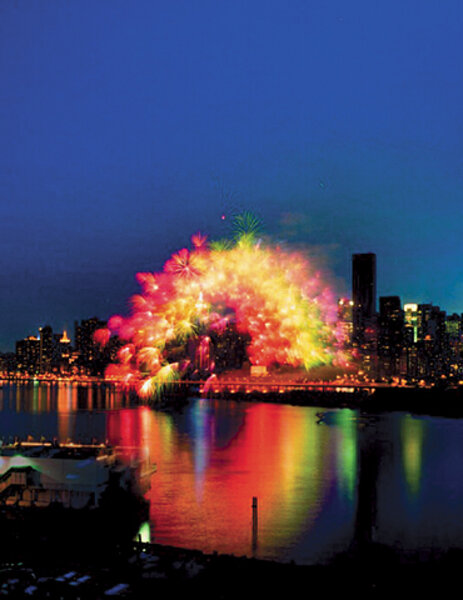How new tricks make Fourth of July fireworks better than ever
Loading...
One year of planning. Fifteen seconds of payoff.
The Gruccis are used to this sort of math. For five generations, this family of fireworks experts has turned careful planning into concussive performances.
But the art of blasting colored skies into peoples' memories has changed greatly in recent years, as computers have begun to run the show.
"Each and every one of our shells now has its own computer chip," says Philip Butler, producer and "chief operating brother-in-law" for Fireworks by Grucci in Brookhaven, N.Y. "Now we can orient each and every show perfectly."
When Mr. Butler married into the family business, the Gruccis couldn't pull off many of the tricks that now make it famous in the world of fireworks. Yet in the last decade, the craft of gunpowder and paper has turned into a science of chemistry and computer chips, allowing for more elaborate, more colorful, and safer spectacles than ever before.
This Independence Day, about 60 percent of fireworks shows will rely on old-school pyrotechnics: hand-firing various shells in loose order. There's nothing wrong with this style, says Julie Heckman, executive director of the American Pyrotechnics Association in Bethesda, Md. It's satisfied viewers for decades, if not centuries. But she is nudging the industry away from this tradition.
The share of hand-fired displays has dropped dramatically since 2000, thanks to safety codes and a bit of one-upmanship from the cities and companies that hire pyrotechnicians.
Electronically fired shows, such as the Gruccis', allow for millisecond precision, instead of four or five seconds when hand-lit, according to Butler. Experts can now direct blasts to exactly where they want them – to spell words, to form the Olympic rings (as during the Beijing games), or Butler's favorite: to create a full rainbow across the night sky.
The "Transient Rainbow," from Grucci and gunpowder artist Cai Guo-Qiang, forms a 300-foot arch of colored bursts. One thousand shells fire in just 15 seconds. With computer-assisted timing, the group can place each of its seven different colors perfectly in space, as if using pixels to create a full picture.
There's definitely a pot of gold at the end of this rainbow.
"All the large-city Fourth of July shows are going to be well choreographed, computer-fired, and they are probably going to be six figures," says Ms. Heckman.
Despite the recession, the industry has grown every year in the United States since the 1990s. Revenue has more than doubled since 1998, with $316 million spent on display fireworks each year and twice that on consumer products.
Some growth comes from the increasing sophistication of shows. Pyrotechnicians also have a busier schedule. "Until recently, we were predominately only a Fourth of July business," says Stephen Vitale, president of Pyrotecnico in New Castle, Pa., where his great-grandfather Constantino Vitale settled after moving the family trade from Italy to the States. "Now we have 2,500 shows annually, and only about 40 percent in July."
The elder Vitale would barely recognize the planning behind today's fireworks shows. Rocco Vitale, Stephen's younger brother and Pyrotecnico's chief choreographer, begins at a computer. He selects music for the event, then listens to the playlist again and again, placing markers that signify every blast.
The software knows his inventory. So when he inputs a shell that takes 3.2 seconds to explode, it automatically adjusts for the delay. It cannot visualize each crackle and pop – the Vitales need to imagine the final product. Once completed, the cues are loaded into the firing computer, which takes over from there.
As Americans master split-second timing, Europeans are finally unlocking new colors beyond the standard palette of red, white, pale blue, green, silver, and gold.
"Now we have pink and lavender and chartreuse, every color you can think of, which was impossible until recently," says Heckman. "If you see a really deep blue, you're seeing a good show. It's taken a lot of tweaking to perfect deep blue."






